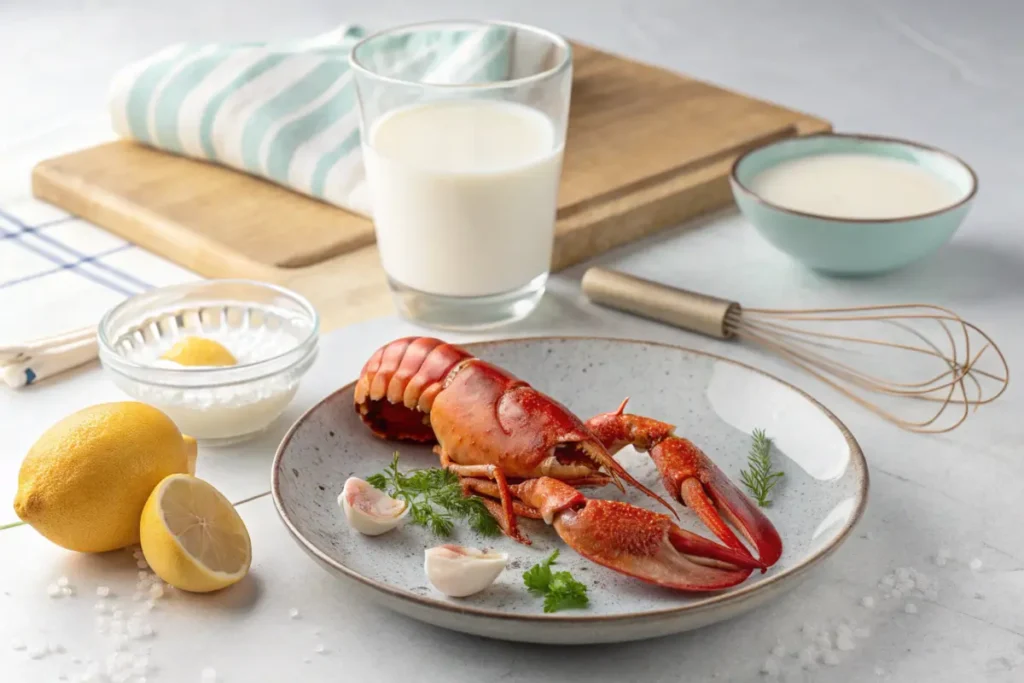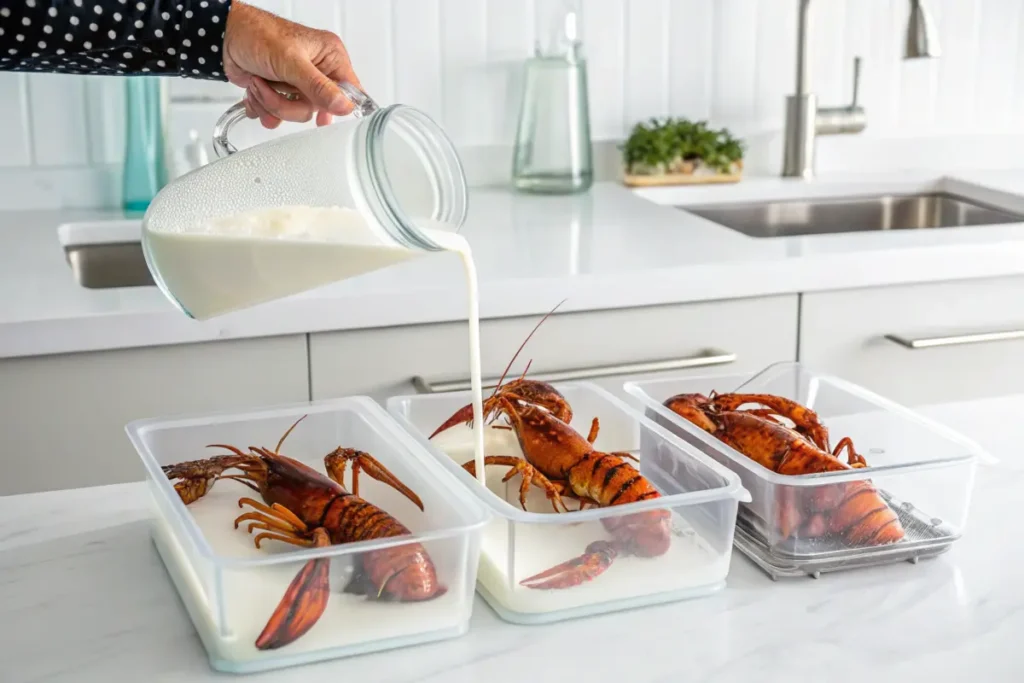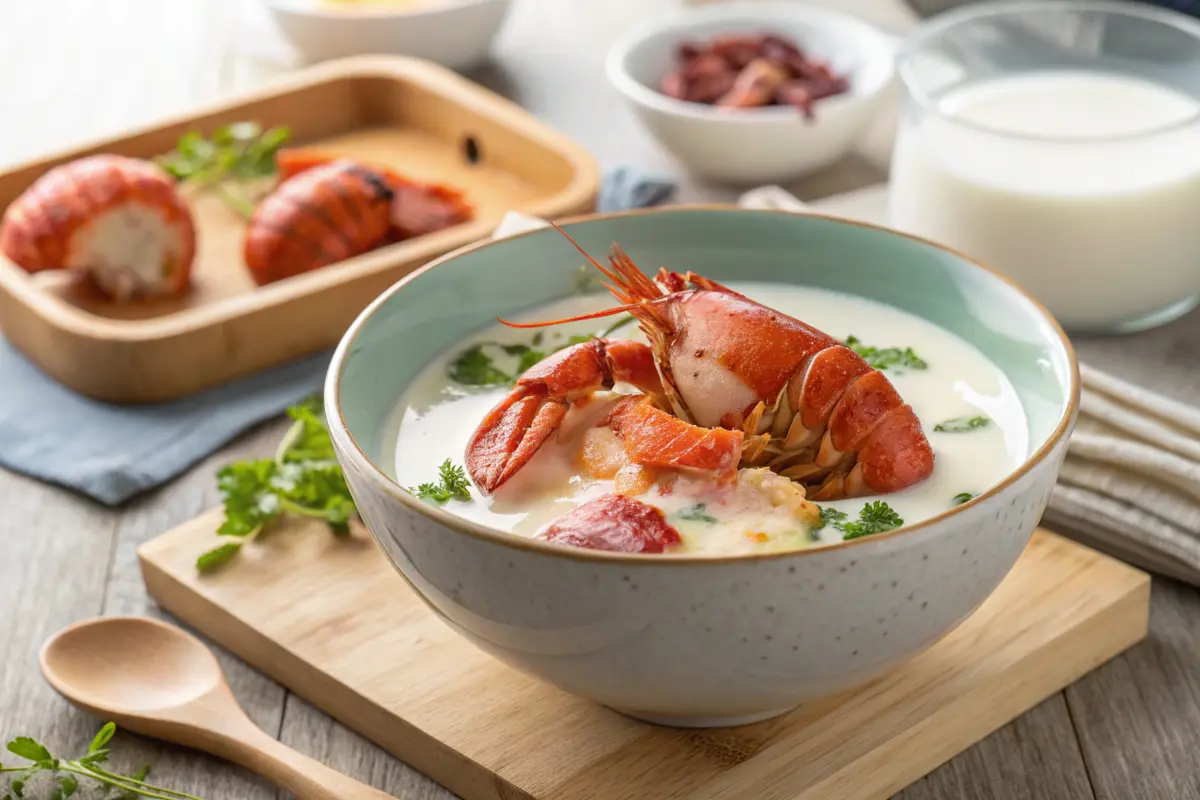Lobster is considered a luxurious delicacy, but preparing it can be tricky. One popular method that leaves many people curious is why you soak lobster in milk. This seemingly simple step has scientific, culinary, and cultural significance. It’s a technique used to neutralize odors, tenderize the meat, and enhance overall flavor. In this article, we’ll dive into the reasons behind this method, its benefits, and how to do it correctly for the best results.
Introduction to Soaking Lobster in Milk
Soaking lobster in milk might seem unusual at first glance, but it’s a tried-and-true technique in seafood preparation. The process involves immersing lobster meat, either raw or partially cooked, in milk for a specific duration before final preparation.
The main reason for this method? Milk is known for its natural ability to tenderize proteins and neutralize strong odors. By doing so, it ensures that the lobster meat tastes fresh and retains a soft, juicy texture. This approach is especially beneficial for those who find lobster’s natural aroma too strong or its texture a bit tough.
Additionally, soaking lobster in milk allows the meat to absorb subtle flavors, creating a more refined dining experience. From scientific explanations to practical steps, this guide will cover everything you need to know to perfect this method.
Purpose of Soaking Lobster in Milk
The practice of soaking lobster in milk isn’t just a random culinary tradition—it has clear, practical benefits that can transform your seafood experience. Let’s uncover its main purposes, from eliminating unpleasant odors to enhancing texture.
Neutralizing Fishy Odors

One of the most common reasons to soak lobster in milk is to neutralize fishy odors. The natural scent of lobster, while appetizing to some, can be overwhelming or off-putting to others. Here’s where milk works its magic.
Milk contains casein, a protein that binds to odor-causing compounds like trimethylamine (TMA). TMA is responsible for the strong “fishy” smell often associated with seafood. When lobster meat is soaked in milk, the casein attaches to these molecules, reducing their intensity and leaving the meat with a fresher, more neutral aroma.
This technique is especially helpful if you’re working with frozen or older lobster, as these tend to develop stronger odors over time. With just a simple soak, you can ensure the lobster’s natural sweetness shines through, free of overpowering smells.
Tenderizing the Meat
In addition to improving aroma, soaking in milk helps tenderize the lobster meat. Lobster can sometimes have a slightly chewy texture, particularly if overcooked or not properly prepared. Milk’s enzymes and natural acidity work together to soften tough muscle fibers in the meat.
This process not only enhances the overall texture but also helps the lobster retain moisture during cooking. The result? Juicy, succulent meat that melts in your mouth. By integrating this step into your preparation process, you’ll elevate the quality of your dish without adding complexity.
Scientific Explanation
Understanding the science behind soaking lobster in milk adds depth to this culinary technique. Let’s explore how milk’s components interact with lobster meat to deliver its benefits.
Role of Casein in Odor Reduction
Milk’s casein protein plays a critical role in reducing strong seafood odors. Trimethylamine (TMA), a compound produced as seafood breaks down, is highly volatile and responsible for the “fishy” smell. When you soak lobster in milk, the casein molecules bond with TMA, effectively neutralizing its potency.
This chemical interaction not only removes the unwanted smell but also prevents it from re-emerging during cooking. Thanks to this process, milk-soaked lobster retains its natural aroma while shedding the sharper, less pleasant notes that can sometimes overpower seafood dishes.
Impact on Texture and Moisture Retention
Milk’s ability to improve the texture of lobster lies in its unique composition. Enzymes present in milk gently break down proteins in the lobster’s muscle fibers, making the meat tender and more enjoyable to eat.
Furthermore, milk acts as a hydrating agent. By soaking the lobster, the milk penetrates the meat, creating a protective barrier that locks in moisture. This ensures that even after cooking, the lobster remains juicy and flavorful rather than dry or rubbery.
These scientific insights highlight why milk soaking has become a trusted method among chefs and home cooks alike—it’s a simple, effective way to enhance both flavor and texture.
Historical Context and Traditional Practices

The practice of soaking lobster in milk has roots in traditional seafood preparation methods passed down through generations. While the exact origins are unclear, this technique is believed to have originated in regions where seafood was a dietary staple and ensuring its freshness was critical. Milk soaking was a practical solution to neutralize odors and improve texture, making even older or less-than-perfect seafood more palatable.
In coastal communities, where lobster and other shellfish were abundant, milk was often used as a natural tenderizer and flavor enhancer. Its ability to soften tough fibers made it a go-to method for preparing lobster before cooking. The technique wasn’t just limited to lobster—similar practices were used for fish and other seafood to preserve freshness and create a milder taste.
Beyond seafood, the use of milk or dairy in tenderizing proteins has parallels in many culinary traditions. For example, buttermilk is commonly used in Southern cuisine to tenderize chicken before frying, and yogurt marinades are a staple in Indian cooking for meats like lamb and chicken. These shared practices highlight dairy’s universal role as a natural tenderizer and flavor enhancer in diverse cuisines.
Today, soaking lobster in milk remains a trusted technique, blending tradition with modern culinary science to create dishes that are flavorful, tender, and aromatic.
Alternative Methods to Milk Soaking
While soaking lobster in milk is highly effective, there are alternative methods to achieve similar results, each with its unique benefits.
Using Buttermilk: Acidity Meets Fat
Buttermilk is a fantastic alternative to milk for tenderizing lobster. It combines the creamy texture of milk with a slight tanginess, thanks to its natural acidity. This acidity helps break down proteins in lobster meat, making it tender and juicy.
To use buttermilk, submerge the lobster meat in a bowl of chilled buttermilk for 15–30 minutes. The added tang of buttermilk can also subtly enhance the flavor of the lobster, adding a mild, zesty note that pairs well with many seafood dishes. Like milk, buttermilk is especially effective in neutralizing strong odors, making it a versatile choice for seafood preparation.
Brining Techniques: Saltwater Solutions
Brining is another popular method for improving the flavor and texture of lobster. This technique involves soaking the lobster meat in a saltwater solution, which draws out unwanted compounds and infuses the meat with a subtle seasoning.
To prepare a brine, dissolve salt in water at a ratio of 1/4 cup salt to 4 cups water. For added flavor, you can incorporate sugar, herbs, or spices. Submerge the lobster in the brine and let it soak for 15–20 minutes. Brining not only tenderizes the meat but also enhances its natural sweetness, making it an excellent choice for lobster dishes.
These alternatives, whether using buttermilk or brine, offer effective ways to prepare lobster while catering to different preferences and flavor profiles.
Step-by-Step Guide to Soaking Lobster in Milk

Soaking lobster in milk is a simple yet transformative method that ensures tender, flavorful, and odor-free meat. Follow this step-by-step guide to master the technique and achieve delicious results.
Selecting the Right Milk
Choosing the right milk is essential for this method. Whole milk is the preferred option because of its higher fat content, which contributes to tenderizing the meat and neutralizing odors effectively. The fat in whole milk binds to strong-smelling compounds and softens the fibers in lobster meat.
If whole milk isn’t available, skim milk can work, though it may be less effective due to its lower fat content. Non-dairy alternatives like almond or oat milk are not ideal as they lack the proteins and fats needed for the process. However, if using a non-dairy option is necessary, select unsweetened varieties to avoid altering the flavor of the lobster.
Soaking Duration and Temperature
Timing and temperature are crucial for successful milk soaking. Start by placing the lobster meat in a shallow bowl or dish and fully submerging it in chilled milk.
- Duration: For optimal results, soak the lobster for 15–30 minutes. Longer soaking times are unnecessary and could affect the texture of the meat.
- Temperature: Always use cold milk to maintain the freshness of the lobster and prevent spoilage. Keep the soaking dish in the refrigerator during this step.
Proper soaking allows the milk’s proteins and enzymes to work their magic, neutralizing odors and tenderizing the meat without over-softening it.
Post-Soaking Preparation
After soaking, remove the lobster meat from the milk and gently rinse it under cold water to eliminate any residual milk. Pat the meat dry with a paper towel before proceeding with your recipe.
Cook the lobster using your preferred method, such as steaming, grilling, or broiling. The meat will be noticeably tender and free of overpowering odors, allowing the lobster’s natural sweetness to shine through.
Common Mistakes to Avoid
While soaking lobster in milk is a straightforward process, a few common mistakes can compromise the results. Avoid these pitfalls to ensure your lobster meat turns out perfectly tender and flavorful.
Soaking for Too Long
One of the most frequent errors is leaving the lobster meat in milk for an extended period. Over-soaking can lead to mushy textures as the milk’s enzymes continue to break down the proteins. To avoid this, limit the soaking time to 15–30 minutes. This duration is sufficient to tenderize the meat and neutralize odors without over-softening it.
Using Milk That’s Too Warm or Too Cold
Temperature is critical in milk soaking. Milk that’s too warm can cause spoilage, especially if left out for too long. On the other hand, milk that’s too cold can slow down the tenderizing process. Always use cold milk and keep the soaking dish in the refrigerator to maintain freshness and prevent bacterial growth.
Skipping the Rinse
Failing to rinse the lobster after soaking is another mistake that can leave residual milk on the meat. This can slightly alter the flavor and texture during cooking. Gently rinse the meat under cold water after soaking to remove any milk remnants.
Choosing the Wrong Milk
Opting for skim milk or sweetened non-dairy alternatives can reduce the effectiveness of this method. Whole milk is ideal for its higher fat content, which enhances tenderizing and odor-neutralizing properties.
Practical Tips
- Use a shallow dish to ensure the lobster meat is fully submerged.
- Pat the meat dry after rinsing to achieve better results when cooking.
- Stick to the recommended soaking time and refrigeration to preserve the lobster’s natural quality.
By avoiding these mistakes, you’ll enjoy tender, flavorful lobster that’s free of unwanted odors and textures.
Frequently Asked Questions
Does soaking lobster in milk affect its flavor?
Yes, soaking lobster in milk can subtly enhance its natural flavors. Milk’s proteins bind with compounds responsible for strong odors, leaving the lobster meat with a cleaner and more delicate taste. While it doesn’t add a distinct flavor, milk soaking ensures that the lobster’s natural sweetness and buttery notes are more pronounced. This makes the dish more enjoyable without altering the essence of the seafood. For those concerned about overpowering aromas, this method provides a perfect balance.
Can I use non-dairy milk alternatives?
Non-dairy milk alternatives like almond or oat milk can be used, but their effectiveness is limited compared to whole milk. Non-dairy options lack casein, the protein responsible for neutralizing odors and tenderizing the meat. If you must use an alternative, choose unsweetened and unflavored varieties to avoid introducing unintended flavors. While non-dairy milk might help slightly, traditional milk or buttermilk remains the most effective choice for this preparation.
Is milk soaking necessary for all lobster dishes?
Milk soaking isn’t required for every lobster recipe but is highly beneficial in certain cases. It’s particularly useful when working with frozen, older, or pre-cooked lobster, where odors and texture can be an issue. For fresh, high-quality lobster, this step may not be as critical but can still improve tenderness and flavor. Consider the dish’s requirements—if the lobster is the star ingredient, milk soaking ensures a premium experience.
How does milk soaking compare to other tenderizing methods?
Milk soaking is unique in its ability to both neutralize odors and tenderize meat gently. Brining, on the other hand, uses saltwater to enhance flavor and texture, often adding a slight seasoning. While effective, brining can change the flavor profile more than milk soaking. Methods like marinating in acidic liquids (e.g., lemon juice or vinegar) can tenderize but may introduce a tangy flavor. Milk soaking stands out for its subtlety and versatility, making it an excellent choice for preserving the natural taste of lobster.

